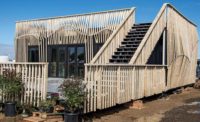The decision to cool classrooms, the auditorium and atrium with displacement ventilation, a system that distributes rising air through flooring, was dictated by the ways in which the spaces are used, says Bodenschatz. "High-volume spaces are conducive to creating stratified zones where we only condition those portions of the space that are occupied. In classrooms, the system significantly improves ventilation effectiveness. You don't need to bring in nearly as much air."
By comparison, chilled-beam cooling, a convection system that pipes water through a ceiling-mounted heat exchanger, "works very well with electronics labs because they don't contain a lot of moisture," says Bodenschatz. "Chilled beams are compatible with the sensible loads those spaces generate." As ECE's primary source of cooling, the chilled beams will yield ECE 10% in energy savings.
Once mechanical systems were selected, "the next step was grouping classrooms, labs and the like in a fashion that minimized distribution requirements," says Bodenschatz. "That also saved us energy."
During planning, project team members compared projected energy savings to a minimal code-compliant baseline building indicated in LEED requirements. Early studies involved the use of e-QUEST, a simulation software well suited to conceptual design work, says Bodenschatz. Later studies employed Trane's Trace 700, a program Bodenschatz says is capable of evaluating more detailed plans.
To confirm results, designers compared savings with historical data for similar buildings. They also subjected the systems to life-cycle cost analyses similar to those performed on the rainscreen. For insulated glazing, for instance, planners evaluated numerous options before selecting a dual-pane assembly composed of a 1/4-in. outer pane with low-E coating on its No. 2 surface, a 1/2-in.-argon-filled air space and a 1/4-in.-low-iron pane.
The research was worth the effort. "A triple-pane assembly was more energy efficient, but the savings weren't sufficient to justify the added cost," says Krein. "You can't boil the ocean, so it becomes a matter of carefully weighing every available option in terms of priority, energy savings and life cycle."





Post a comment to this article
Report Abusive Comment